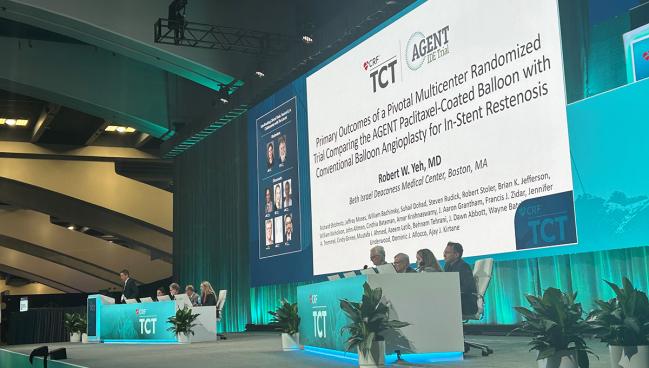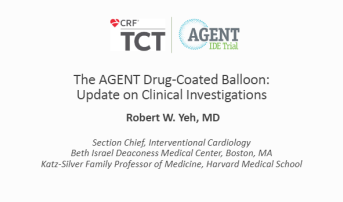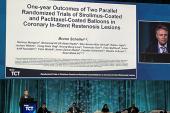‘Light at the End of the Tunnel’ for In-Stent Restenosis: AGENT IDE Wins Big
(UPDATED) The results may pave the way for the first coronary DCB available to US physicians. “It’s exciting,” B. Hadley Wilson says.

SAN FRANCISCO, CA—The Agent paclitaxel-coated balloon (Boston Scientific) had a major positive impact in patients with in-stent restenosis compared with conventional balloon angioplasty in the randomized AGENT IDE trial, sparking excitement among US physicians who remain without an approved coronary DCB option.
Target lesion failure (primary endpoint) occurred in 17.9% of Agent-treated patients and 28.7% of controls through a year of follow-up, a 10.7% absolute difference (P = 0.0063) that was driven by a relative halving of the risks of TLR and target-vessel MI, Robert Yeh, MD (Beth Israel Deaconess Medical Center, Boston, MA), reported here at TCT 2023.
There were no cases of definite/probable stent thrombosis in the Agent arm, compared with six following conventional balloon angioplasty (P = 0.001).
Yeh noted that this is the first RCT conducted in the United States to evaluate the safety and efficacy of a DCB for the treatment of coronary in-stent restenosis, which—despite advances in stent technology—remains a problem, accounting for about 10% of all PCIs performed. Although coronary DCB have been available in Japan and Europe for years, none have yet been approved by the US Food and Drug Administration.
“Given the marked superiority over conventional balloon angioplasty, I believe that the Agent DCB is likely to become an important treatment option for patients with coronary restenosis in the United States,” Yeh said during a press conference.
Speaking with TCTMD, B. Hadley Wilson, MD (Sanger Heart & Vascular Institute, Atrium Health, Charlotte, NC), president of the American College of Cardiology, said the results are “very encouraging” and alluded to less-than-ideal results with other options for treating in-stent restenosis, including additional layers of stent, conventional balloon angioplasty, and intracoronary brachytherapy.
“We don’t really have a good answer for it right now, and this might be the answer,” Wilson said. “I think it’s exciting that here is a modality that we can use for in-stent restenosis that looks to be very effective. . . . This looks like the most promising of any of the modalities we’ve seen so far.”
AGENT IDE
The AGENT IDE trial, conducted at 40 US sites, provides the primary evidence that will be used to support FDA approval of the Agent DCB, which has been granted the agency’s breakthrough device designation, Yeh said.
The trial, with a superiority design, will ultimately include 600 patients with in-stent restenosis of a lesion previously treated with either a BMS or DES, with 2:1 randomization to either the Agent DCB or conventional angioplasty after successful predilatation of the target lesion. Dual antiplatelet therapy (DAPT) is required for at least a month after the procedure, followed by antiplatelet monotherapy for the duration of the study.
Yeh presented the results of the first 480 patients enrolled (mean age about 68 years; 27% women), a sample size determined to provide adequate statistical power for the primary analysis through discussions with the FDA. He noted that the patient cohort was very high risk overall, with about 50% having diabetes, the same proportion having a history of MI, and 78% having multivessel disease. Moreover, about 43% of patients already had multiple stent layers within the artery. The indication for the initial PCI was stable angina in just over half of patients and NSTE ACS in about 38%.
This looks like the most promising of any of the modalities we’ve seen so far. B. Hadley Wilson
Before the procedure, which involved intravascular imaging in about three-quarters of patients, the mean lesion length was 12.97 mm in the Agent group and 11.88 mm in the control group. Mean minimal lumen diameter started out at 0.95 and 0.94 mm, respectively, while mean diameter stenosis was 65% and 66%. After the procedure, mean minimal lumen diameter increased to 2.13 mm in the Agent group and 2.15 mm in the control group. Mean diameter stenosis dropped to about 22% in both groups.
At the 1-year mark, use of antiplatelet therapy was similar in the two groups, with about 85% on aspirin and three-quarters on DAPT.
The primary endpoint of target lesion failure was a composite of TLR, target-vessel MI, or cardiac death. The reduction at 1 year with the Agent DCB was driven by significant differences in TLR (12.4% vs 24.0%; HR 0.49; 95% CI 0.31-0.78) and target-vessel MI (6.4% vs 12.3%; HR 0.51; 95% CI 0.27-0.95), with no difference in cardiac death (3.0% vs 2.0%; P = 0.55).
Subgroup analyses showed consistent results for the primary endpoint, including among patients with and without multiple stent layers.
There was a borderline significant advantage for the Agent DCB in terms of overall MI (8.3% vs 13.6%; p=0.05), along with significantly lower rates of TVR (13.7% vs 25.3%; P = 0.003) and target-vessel failure (17.8% vs 29.5%; P = 0.004).
‘So Much Clinical Need and Urgency’
Yeh pointed out that the trial enrolled very quickly. “There was so much clinical need and urgency out there for wanting a device like this, and that was reflected in the fast rate of enrollment,” he said. “I anticipate that if this device were to become available that you’re going to see a fair amount of utilization for this population in particular.”
Ajay Kirtane, MD (NewYork-Presbyterian/Columbia University Irving Medical Center, New York, NY), who is the AGENT IDE study chair and who moderated the press conference, added that the scope of the problem of in-stent restenosis in the US is immense. He noted that the first RCT of a coronary DCB was done in 2006 in Europe, where physicians have had commercial access to the devices for over a decade. US physicians, meanwhile, have been hamstrung by lack of the technology. “It’s been literally embarrassing as a clinician in the United States,” Kirtane said.
Róisín Colleran, MBBCh (Cardiovascular Research Institute Dublin, Mater Private Network, Ireland), who served as the discussant following Yeh’s presentation, underscored the marked difference in the treatment of in-stent restenosis between Europe and the US by noting that European guidelines have included a class I recommendation for DCB in this setting since 2014. In that context, AGENT IDE “is long overdue,” she said.
“In any event,” Colleran said, “I think the implications are clear: this trial should provide a basis for regulatory approval of this drug-coated balloon for treatment of in-stent restenosis in the US and finally provide this as an available treatment option for such patients.”
At the press conference, a panel discussion indicated that the availability of a coronary DCB in the US would make a big impact.
John Messenger, MD (University of Colorado School of Medicine, Aurora), noted that the 1-year rate of MI in this population is “staggeringly high,” calling the relative 50% reduction in target-vessel MI observed in AGENT IDE “incredible.”
If the Agent DCB is approved by the FDA, he said, “this really would offer patients in the United States the opportunity to have definitive therapy up front, [which] I think really is going to be fantastic for patients and for reducing costs and improving care.”
“This is a real game changer,” Wilson predicted. “For 25 years, we’ve been trying to peel back this restenosis problem, and I think now we can see light at the end of the tunnel, so this is really terrific work.”
Todd Neale is the Associate News Editor for TCTMD and a Senior Medical Journalist. He got his start in journalism at …
Read Full BioSources
Yeh RW. Primary outcomes of a pivotal multicenter randomized trial comparing the Agent paclitaxel-coated balloon with conventional balloon angioplasty for in-stent restenosis. Presented at: TCT 2023. October 25, 2023. San Francisco, CA.
Disclosures
- Yeh reports receiving grants/research support from Abbott Vascular, BD Bard, Boston Scientific, Cook Medical, Philips Medical, and Medtronic, and consulting for Abbott Vascular, Boston Scientific, CathWorks, Elixir Medical, Infraredx, Medtronic, Shockwave Medical, and Zoll.
- Wilson reports no relevant conflicts of interest.






Comments